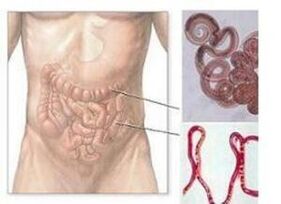Parasites are organisms whose existence is directly related to their host. In other words, parasitic organisms live off the host, exploit the host for their own benefit, and at the same time negatively affect the host. These creatures are extremely hardy and reproduce at a high rate, so fighting them is quite a difficult task. This type of organism includes: viruses, bacteria, fungi and protozoa. In especially severe cases, the parasites take away all the juices of their owner, poison him with the products of their vital activity and seriously damage his health. How to identify parasites in the human body?
Who are parasites?

Parasites are organisms that exist entirely thanks to the host organism, and at the same time have a negative effect on the host organism. These include many types of bacteria, fungi, protozoa and worms. Bacteria are the smallest in size. Despite this, they can be causative agents of quite serious diseases, among them:
- disaster
- typhus
- tuberculosis
- Tetanus
- meningitis, etc. v.
Fungal parasites are the next most developed organisms of this type. There are up to a hundred species of fungi that cause disease. They are slightly larger in size than bacteria and unlike them, they have excellent protection from environmental factors and are also able to adapt well to changing environmental conditions. They are divided into two groups: filamentous fungi and yeast. The most prominent representative of this type of parasite is the fungus Candida. They affect the host's skin, nails and mucous membranes and are the causative agents of candidiasis.
The most common parasites are helminths. They include many species that live in different host systems. The roundworm, trichina, causes a disease called trichinosis. This disease can affect both humans and pigs. Tapeworms, belonging to the class of flatworms, are intestinal parasites. They live in the digestive system of the host organism and feed at its expense.

Usually, their hosts are vertebrates: humans, cats, dogs, fish. Tapeworms have special suction cups to attach to the intestinal wall. They absorb nutrients throughout the body, as their primitive structure does not provide a digestive tract or any sense organs.
There are a lot of tapeworms. The length of these parasites varies from one-tenth of a centimeter to nine meters. Their body structure is also very diverse: they can be a complete organism or consist of segments connected together in a chain. Flatworms are hermaphrodites - each representative of the species is both male and female.
An equally common type of parasitic roundworm is the nematode. The most famous of them: roundworm, pinworm, trichinella. Unlike tapeworms, they have an oral cavity, through which they feed on nutrients obtained from the host. Most of them are heterosexual, but like tapeworms, there are hermaphrodites - organisms with sexual characteristics of both sexes.
Parasites are organisms that live exclusively on a host. Unlike other organisms that live in symbiosis with the human body, they constantly harm it due to their vital activity. Parasites include: protozoa, bacteria, fungi, helminths.
Parasite infection routes
There are many ways for parasites to enter the human body, the main ways are:
- nutrition– through contaminated food and water;
- household contact– Infection occurs through contact with contaminated objects, family members, pets;
- can be transmitted– infection occurs through blood-sucking insects;
- positive– parasites enter the human body when exposed to contaminated soil or when swimming in ponds.
nutrition

Among the types of helminths transmitted through food, it is necessary to clearly distinguish those transmitted through meat products. The most dangerous of them are pork and beef tapeworms. Beef tapeworms can live in the human body for up to 10 years, ranging from 3 to 10 meters long. Pork tapeworms, settling in the intestines and beginning to multiply, infect the entire human body with the help of cysticerci.
Additionally, the meat of some animals may be contaminated with Trichinella. A few days after Trichinella enters the human body, it develops a serious disease - trichinosis. It often ends in death. When buying meat, you should always pay attention to the seller. Because he is directly involved with food, his responsibilities include regular health checks and strict compliance with hygiene standards. Unfortunately, in our time, very few people monitor this, which is why such foci of diseases arise.
In addition, from the perspective of helminth infection, freshwater fish is a dangerous product. For example, cyprinids can cause diseases such as opisthorchiasis. The eggs of this parasite enter the fish through river mollusks and have practically no effect on the fish - it only serves as a carrier of the parasite.
Dried, smoked or dried fish pose a serious danger. For example, raw caviar can be contaminated with broad tapeworms. Diphyllobothrosis is a disease caused by this worm. Broad tapeworms can grow up to 10 meters long and parasitize the small intestine for decades.
Contact and household
The most common types of helminths spread this way are pinworms and roundworms. Violations of hygiene rules are the main cause of ascariasis and whipworm. A child infected with pinworms scratches his anus while sleeping because the female pinworms come out and lay eggs, then many household items and clothes become infected.
If not detected in time, all family members can get the disease. Giardiasis can be contracted by drinking contaminated water. This parasite can survive even in chlorinated water. In addition, household items: toys, dishes can also be a source of infection with these parasites.
Path of infection
Filariasis is a type of helminth disease that can be transmitted by certain species of mosquitoes common in tropical and subtropical climates. Malaria or yellow fever is a deadly disease also transmitted by mosquitoes. Filariasis can live in the blood and lymph, causing various negative reactions in the host.
Active route of infection
In this case, the parasite infects humans through direct contact with contaminated water or soil. For example, hookworm is a parasite that can be infected simply by walking barefoot on contaminated soil.
There are many ways to transmit parasites, of which there are 4 main ways. To somehow protect yourself from infection, you must carefully follow the rules of personal hygiene and try not to eat questionable foods, especially meat.
How to identify parasites in the body

Symptoms of a parasitic infection can vary widely. Parasites can be recognized when the following signs appear:
- Constipation. Due to their size and large number, some types of worms can cause blockages in various systems of the body: bile ducts, intestines. These blockages lead to a certain type of disease and in particularly severe cases require surgical intervention.
- Diarrhea. Parasites, due to their vital activity, produce substances similar to prostaglandins, which cause loose and frequent stools in the host.
- flatulence. During their lives, worms can often cause enteritis. These inflammatory processes cause excessive gas formation, leading to bloating.
- Allergy. Damaged lining of the digestive tract can cause undigested food molecules to enter the bloodstream. In this case, the immune system comes into play and as a result of its reaction, a large number of eosinophils, inflammatory cells, are released into the blood, indicating an allergic reaction in the body.
- Bad skin. Many different skin diseases can be caused by parasitic organisms on the skin.
- Weight problem. Deviation in weight from the norm, both up and down, can be a sign of the presence of parasites in the body. Weight loss occurs due to indigestion and loss of appetite. Some types of helminths reduce blood sugar levels, causing the host to feel uncontrollable hunger, leading to obesity.
- Chronic fatigue. Weakness, flu-like conditions, lethargy, poor concentration and memory are common signs of poor nutrition. In case of helminth infection, the function of the digestive system is impaired and therefore the ability to absorb various nutrients is impaired, leading to chronic fatigue.
- Respiratory tract inflammation. Some types of worms travel throughout the human body, including the respiratory system. In some cases, they cause lung disorders, causing cough and fever. Roundworms can even cause diseases such as pneumonia.
- worry. The human nervous system can be seriously damaged by exposure to helminth waste. Various neurological disorders are signs of helminth poisoning in the body.
Identifying parasites in the human body is not entirely easy. Although the signs of their presence in the body are quite obvious, however, they can be misinterpreted and attributed to a completely different disease. Therefore, the best way to detect parasites in the body is to consult a doctor and undergo the necessary tests.
Parasites are different organisms that live by parasitizing another organism. Due to their vital activity, the host's ability to survive is significantly reduced. There are many ways to become infected with parasites, which literally surround a person. Symptoms of infection are quite diverse and if you suspect a parasitic infection, you should consult a doctor and undergo an examination.























